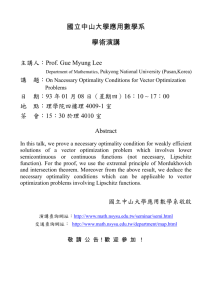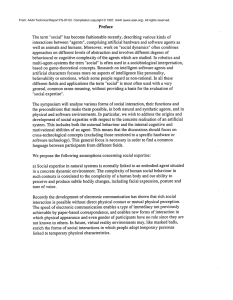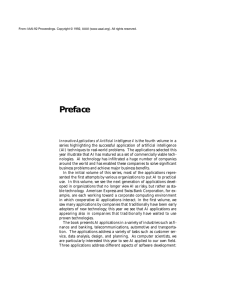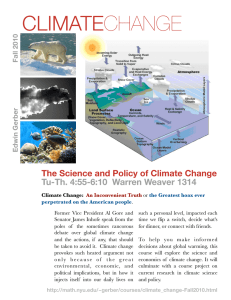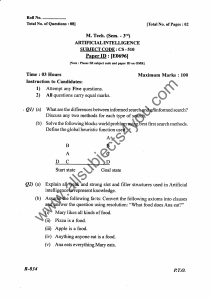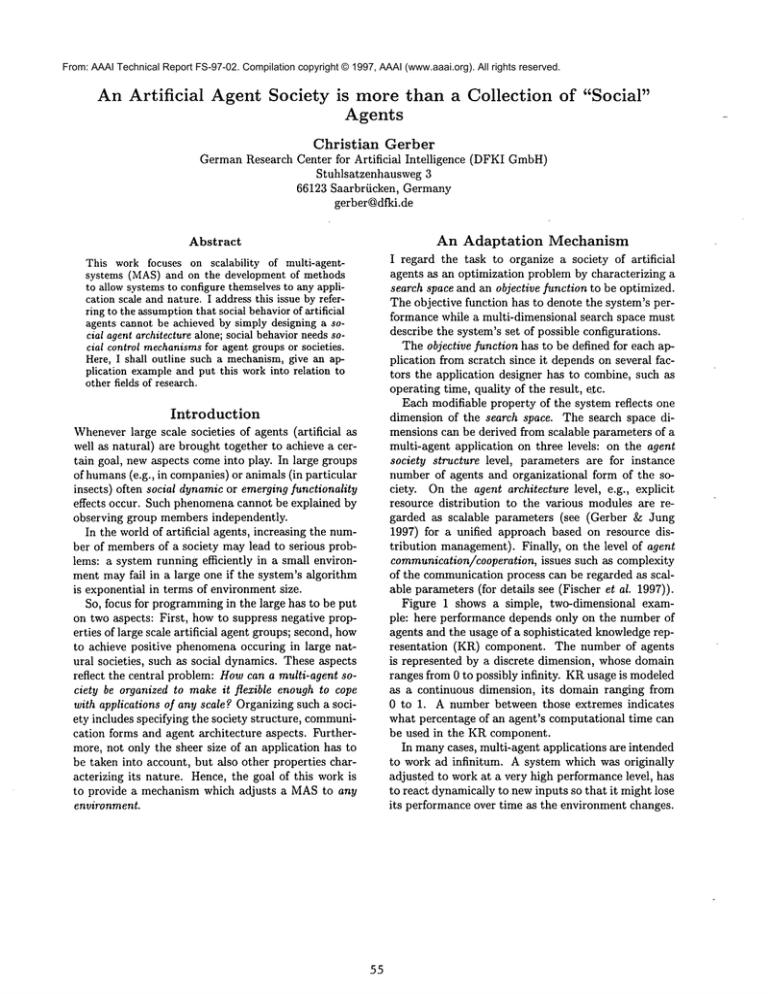
From: AAAI Technical Report FS-97-02. Compilation copyright © 1997, AAAI (www.aaai.org). All rights reserved.
An Artificial
Agent Society is more than a Collection
Agents
Christian
Gerber
German Research Center for Artificial
Intelligence
Stuhlsatzenhausweg
3
66123 Saarbrficken,
Germany
gerber@dfld.de
Abstract
An
of "Social"
(DFKI GmbH)
Adaptation
Mechanism
I regard the task to organize a society of artificial
agents as an optimization problem by characterizing a
search space and an objective function to be optimized.
The objective function has to denote the system’s performance while a multi-dimensional search space must
describe the system’s set of possible configurations.
The objective function has to be defined for each application from scratch since it depends on several factors the application designer has to combine, such as
operating time, quality of the result, etc.
Each modifiable property of the system reflects one
dimension of the search space. The search space dimensions can be derived from scalable parameters of a
multi-agent application on three levels: on the agent
society structure level, parameters are for instance
number of agents and organizational
form of the society. On the agent architecture level, e.g., explicit
resource distribution
to the various modules are regarded as scalable parameters (see (Gerber & Jung
1997) for a unified approach based on resource distribution management). Finally, on the level of agent
communication/cooperation,
issues such as complexity
of the communication process can be regarded as scalable parameters (for details see (Fischer et al. 1997)).
Figure 1 shows a simple, two-dimensional
example: here performance depends only on the number of
agents and the usage of a sophisticated knowledge representation
(KR) component. The number of agents
is represented by a discrete dimension, whose domain
ranges from 0 to possibly infinity. KR usage is modeled
as a continuous dimension, its domain ranging from
0 to 1. A number between those extremes indicates
what percentage of an agent’s computational time can
be used in the KR component.
In many cases, multi-agent applications are intended
to work ad infinitum. A system which was originally
adjusted to work at a very high performance level, has
to react dynamically to new inputs so that it might lose
its performance over time as the environment changes.
This work focuses on scalability
of multi-agentsystems (MAS) and on the development of methods
to allow systems to configure themselves to any application scale and nature. I address this issue by referring to the assumptionthat social behavior of artificial
agents cannot be achieved by simply designing a social agent architecture alone; social behavior needs social control mechanismsfor agent groups or societies.
Here, I shall outline such a mechanism, give an application example and put this work into relation to
other fields of research.
Introduction
Wheneverlarge scale societies of agents (artificial
as
well as natural) are brought together to achieve a certain goal, new aspects come into play. In large groups
of humans(e.g., in companies) or animals (in particular
insects) often social dynamic or emerging functionality
effects occur. Such phenomena cannot be explained by
observing group members independently.
In the world of artificial
agents, increasing the number of members of a society may lead to serious problems: a system running efficiently in a small environment may fail in a large one if the system’s algorithm
is exponential in terms of environment size.
So, focus for programming in the large has to be put
on two aspects: First, how to suppress negative properties of large scale artificial agent groups; second, how
to achieve positive phenomena occuring in large natural societies, such as social dynamics. These aspects
reflect the central problem: Howcan a multi-agent society be organized to make it flexible enough to cope
with applications of any scale? Organizing such a society includes specifying the society structure, communication forms and agent architecture
aspects. Fhrthermore, not only the sheer size of an application has to
be taken into account, but also other properties characterizing its nature. Hence, the goal of this work is
to provide a mechanism which adjusts a MASto any
environment.
55
to the run of the system, but also through on-line performance measuring based on a trial-and-error method.
In addition, examination of related fields of research
maylead to further insights: organizational forms defined in organization theory can be used to model substructures of the layout; heuristics about the perfect
size of a group maybe taken from psychology, etc.
Secondly, the structure has to be controlled or monitored in order to detect and removesub-optimalities.
It may not be reasonable to introduce only one such
optimization procedure as too many scahng dimensions mayoccur. It therefore might be wiser to introduce one optimization process for scaling dimensions
which characterize general system properties, several
processes for dimensions characterizing smaller groups
of agents and a process for each agent, addressing dimensionson the agent architecture level.
The latter control structure can be integrated into
the agent architecture.
One approach to construct
the other control mechanismsis to commissioncertain
agents to control optimality conditions. Such monitor
agents can be society members or additional agents
whose sole functionality is to monitor. They monitor
optimality conditions by applying them in a feedback
loop, or by controlling themin a daemon-like fashion.
Figure 1: Example of a System Performance Relation
Maintenanceof high performance is therefore another
mainissue. By applying optimality conditions to a current situation the system shall be able to detect suboptimalities. In the following, I present a mechanism
for achieving and maintaining high performance during the complete run of an application. As global optimality can hardly be achieved in a reasonable amount
of time, but may be lost very easily, this mechanism
bases on the steepest ascent method(Zoutendjk 1976)
for finding local optima. The mechanismis enabled to
include an expert’s intuitive understanding on howto
model an organization.
Method
1. The application designer produces an initial model
of the application by instantiating scalable parameters at the agent society structure, communication/cooperation and on the agent architecture levels.
An Application
Example
The MASsimulation environment SIF (Social Interaction Framework(Funk et al. 1997)) is currently being
developed for’ the study of social interaction between
artificial agents. Here, the environment is populated
by agents that have somesort of "life energy", ranging from 0 (the agent is dead) up to 100 (the agent
is perfectly healthy). Anyactivity an agent performs
results in energy loss. The agents’ main goal is to keep
their life energy as high as possible. Increasing energy
is achieved by consuming food which has be produced
by processing various types of raw material. Cooperation between agents is reasonable because the process
of producing food can hardly be achieved solitary.
Overall goal of the systemis to derive an agent society as strong as possible, i.e.~ that consists of as many
membersas possible. A centralized control of agent activity mayeasily becomeintractable once the society
has reached a certain size. Therefore, I incorporate a
more decentralized and scalable approach: agents are
enabled to found, join, or leave groups. In contrast
to other group formation approaches (e.g., (Ketchpel
1993)), once evolved, agent groups are explicitly represented by a monitor agent equipped with the functionality described in the previous section. Agents groups
again can cluster to larger units which again are represented explicitly.
2. The system detects sub-optimalities in this layout by
applying optimality conditions. The system modifies
the layout in order to remove them. This step may
be performed in interaction with a humanexpert.
3. The second step is repeated until the application is
terminated.
In the above exampleI a starting point may be x3. A
maximal performance gain will be achieved by adding
more resources to the KR component: x4 may be
achieved. By increasing the numberof agents to five,
the optimal configuration x2 will be found.
For the realization of this algorithm two issues must
be addressed: Howto retrieve optimality conditions
mentioned in step 2 and Howto monitor the structure.
(Local) optimality conditions may be retrieved
through a theoretical examinationof scalability quantities (e.g., through bottleneck analysis (Sie 1996)) prior
1Forthe sake of clarity, I assumefor this examplethat
during the optimization process neither the search space
changes, nor does the dependenceof the performancefunction to scalable or non-scalablequantities. Of course, this
assumptiondoes not hold in general. However,the above
search procedurecan still be applied for the general case.
56
The main goal of a group (i.e., the objective function of the corresponding monitor agent) is to gain as
muchcontrol over food as possible in order to enable
the survival of group members.Agent individuals have
unique skills to perform certain jobs. Hence, the monitor agent representing a group must determine how
many agents, what type of agents, what patterns of
command
in the group, etc., are needed to optimize its
objective function. All these parameters reflect search
space dimensions in the optimization problem the monitor agent has to solve.
Agents, on the other hand, have to optimize their
life energy. They have to reason whether or not to
join or leave a certain group. So, not only group formation evolves naturally from goal optimization, but
also agent characteristics such as selfishness, social behavior or solitary behavior, concepts well studied but
mostly represented in an explicite manner.
Related
Fields
This work addresses problems somewherein the intersection of a wide range of research areas, mainly in
the area of cognitive science, allowing to incorporate
research results found in other fields. Furthermore,
there is also the chance that this work will be useful
for these disciplines, for instance, for simulating behavior of large humangroups. Important points of contact
to other fields are described below:
Psychology Group formation and development is
one issue that social psychologists work on. Muchresearch is carried out to find the optimal size of a certain group (see e.g., (Nasser 1988)). Furthermore,
strongly relevant question whypeople form or join certain groups is investigated. ((Tuckman& Jenson 1977)
shows some aspects.)
Biology The examination of the sociology of animal
societies, in particular of phenomenasuch as emerging
functionality in insect societies, is important to how
a society goal is split into subgoals, and then, how
they are achieved. Furthermore, feedback loops regulating the size and structure of insect societies (see
(Free 1987) as an example) are worth looking
Management Theory In business organization,
consultants have the tough job of deciding how to
structure very large companies. Thus, business administration has developed basic organizational forms
for companiesand rules designed for building company
structures. (A survey can be found in (Whhe1981).)
57
Summary
In this paper I have presented an adaptation mechanism which enables multi-agent systems to configure
themselves to any application scale and nature. This
goal is motivated by the necessity to guarantee high
performance of MASof any scale and thus, to achieve
scalability. Furthermore, I have sketched an application exampleto demonstrate the feasibility and practical relevance of the approach. Here, I have shownhow
social phenomenasuch as the degree of social behavior
or group formation can evolve. Finally, related fields
of research were addressed.
Acknowledgments
Part of this work has been supported by Siemens AG
Germany.
References
Fischer, K.; Mfiller, J.; Pischel, M.; Gerber, C.; and
Chaib-draa, B. 1997. A Simulation Approach based
on Negotiation and Cooperation between Agents: A
Case Study. Submitted to: ACMTransaction on
Modeling and ComputerSimulation: Special Issue on
Simulation of Scalable Systems.
Free, J. 1987. Pheromones of Soeia[Bees. London:
Chapman and Hall.
Funk, P.; Gerber, C.; Lind, J.; and Schillo, M. 1997.
Social Interaction Framework--Ageneric Testbed for
Social Agents. Technical report, GermanResearch
Center for Artificial Intelligence. To Appear.
Gerber, C., and Jung, C. 1997. Towardsthe Bounded
Optimal Agent Society. Working Notes of the Workshop on Distributed Cognitive Systems in conjunction
with the 21st Annual GermanConference on Artificial Intelligence (KI-97), To Appear.
Ketchpel, S. 1993. Coalition Forming AmongAutonomous Agents. In Proceedings of the 5th European Workshop on Modelling Autonomous Agents and
Multi Agent Worlds (MAAMAW’93).
Nasser, D. 1988. Howto run a focus group. Public
Relations Journal 44:33-34.
Siemens AG, Zentrabteilung SW2. 1996. Enpaflanalyse -eine neue Methode zur Systembewertung.
Tuckman,B., and Jenson, M. 1977. Stages of smallgroup development revisited. Group and Organization
Studies 2:419-427.
Whhe, G. 1981. Einfiihrung in die AIlgemeine Betriebswirtschaftslehre. Verlag Wahlen,14th edition.
Zoutendjk, G. 1976. Mathematical
Methods. Amsterdam: North-Holland.
Programming


